Hisense A6H Reviewed at $319.00 (55")
Product Name: Hisense A6H
Product Description: 2022 4K UHD TV
-
Design / Build Quality - 8.6/10
8.6/10
-
Image Quality - 8.3/10
8.3/10
-
Ports & Connectivity - 8.8/10
8.8/10
-
OS, Apps and Features - 9.2/10
9.2/10
-
Price / Quality - 9.2/10
9.2/10
Summary
Reviewed at $319.00 (55″)
Pros
- Dolby Vision and VRR support
- Low input lag
- Google TV
- Extremely low price
Cons
- Very low SDR and HDR brightness
- Average contrast
- Mediocre color reproduction
- Audio output only for casual use
Cheapest Places to Buy :
*We are a reader-supported website. When you buy through links on our site, we may earn a small affiliate commission at no extra cost to you. Home Media Entertainment does not accept money for reviews.*
Hisense has been closely following the big three (LG, Samsung and Sony) for a few good years now and they have managed to do so by offering specs at prices none of their competitors can even come close to. And this continues well into 2022 and so today in our Hisense A6H review we will be looking at this low tier offering and determine if Hisense is still able to keep their pricing strategy that made them so famous lately.
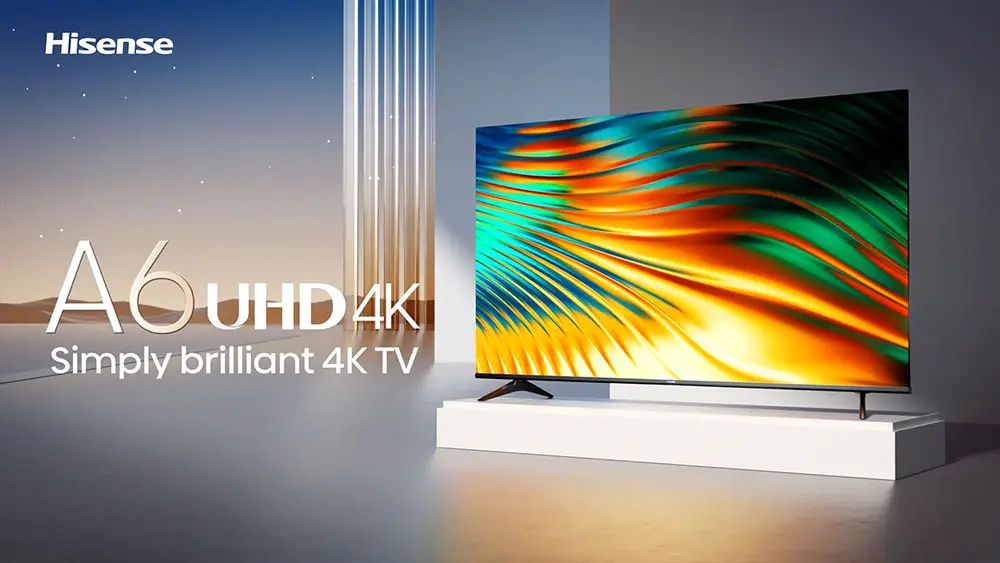
The A6H is the direct replacement of 2021’s A6G that we had reviewed some time ago so it will be interesting to see if there are any changes, if any at all, between these two models. One thing that seems to be the same is that Hisense, for some reason, offers the A6H with different specs in different markets. We have seen different sizes come with both VA and IPS panels while in some markets it comes with the Google TV OS while in others it uses the VIDAA TV OS.
Also different sizes seem to offer slightly different port configurations and number of HDMIs available. The TV we have today for testing is the 55″ A6H specifically for the US market which comes with an IPS panel along with the latest Google TV.
Let’s go very quickly over the specs. The Hisense A6H is a 4K TV that supports both HDR10 and Dolby Vision, uses a 4K quad core processor, comes with an IPS panel with a Direct LED backlight and 60Hz refresh rate, VRR, DTS Virtual:X and uses the latest Google TV 11.0 which includes many features like Chromecast, voice control, Bluetooth streaming and WiFi functionality.
With an initial price of $319 the Hisense A6H seems to sell for much less than what its predecessor did a year ago. The A6G was an already very good, low cost option and Hisense’s aggressive pricing makes the A6H an even more intriguing one. All that remains to be seen is how it performs and if these $319 were put in good use. Without further delays let’s start our analysis.
Design
Before we begin we need to say again that Hisense is releasing the 2022 A6 in a lot of different variations both in terms of design, ports configurations and specs. And because it’s impossible to cover all of them we will speak only for the one we have at hand. Be careful when you look at your specific market that yours may differ a lot compared to what we have in our test unit.
And with that out of the way the 2022 A6H seems to be an almost direct copy of the 2021 A6G. The TV has a thickness of 2.8″ (7.1 cm) making it look nice if placed on a wall without extruding very much. Having a Direct LED backlight instead of a FALD one certainly helps with that.
Its borders and bezels are thin enough and on par to other TVs of the same category. Now, at the back we find all ports on the right side divided into two groups with one looking sideways and the other backwards. The power connector is kept separately, as usual, on the left side while the A6H doesn’t seem to have any special grooves for cable management. The electronics box is located at the middle of the back side and this is where the holes for the VESA wall mount are also found.
The A6H comes with a fairly similar stand to the A6G which is a typical bench type. The legs are made out of plastic which can result in the TV wobbling slightly but not so much to risk falling down. The legs sit far apart from each other so make sure you have a big enough furniture for it.
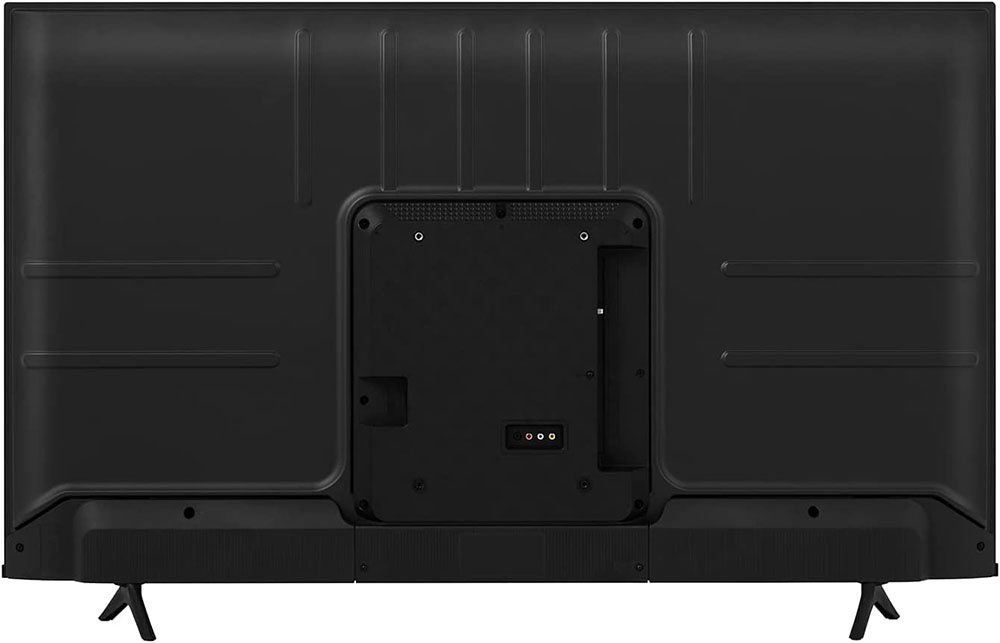
The legs don’t have any special grooves as we have seen in so many other stands of the same type to help hide the cables while their height is measured more than 3″ meaning that most soundbars should fit nicely under it without obstructing the TV’s IR sensor.
While the TV seems to be using almost, if not entirely, the same body design what has changed is the remote. Last year we complained that the remote Hisense was using had far too many buttons for a new smart TV. And it seems they got the message as the new remote vastly improves upon last year’s design with far less buttons and now it surely looks like a smart TV remote.
Gone is the numerical pad while all buttons now have a circular design making them look more modern. All buttons are made of rubber while Hisense has retained the six dedicated buttons at the bottom for the usual Netflix, Amazon Prime, Youtube, Disney+, tubi and peacock. No changes here.
The remote is made out of plastic, its feel is in general good and while it is IR based which means it needs line of sight to work it can also be connected through Bluetooth in order to use its microphone and voice commands feature. The remote may not look as premium as some competing brands but it will do what it was meant to and to be honest with such a low price tag you shouldn’t expect anything more than this.

The A6H looks more like a rebranded A6G than a new release. It is saved of course by the new remote which is a vast improvement over its predecessor and we are glad that Hisense decided to change it.
Video Quality
Processor technology used
Unfortunately Hisense does not provide any detailed information about the processors their TVs are using. For the A6H the only info available is that it is using a 4K quad core processor but there is no more official information about its type or capabilities. There are some basic features for better image quality including 4K upscaling, Noise Reduction and Digital Noise Reduction but that’s all there is to it.
As always we run our usual tests with a variety of material in different resolutions including low resolution broadcasting signals, DVD quality, 720p and 1080p videos. From what we saw the TV had no problems at all and everything upscaled to 4K nicely without any undesirable artifacts.

Lighting technology used
Having so many things in common with the A6G meant that the new A6H would also use the same lighting system which is no other than Direct LED that is used in many low tier releases.
The Direct LED system is using light behind the included IPS panel but is much less capable than a FALD or Mini LED system which means far less brightness output, less light accuracy and lower contrast which means that blacks will appear more greyish than true blacks. And with the A6H’s IPS panel low contrast capabilities the omission of Local Dimming makes things even worse.
Having a Direct LED system is pretty common the last few years in the lower end, budget friendly categories and in line with what we have seen in many other TVs with lower capabilities. At least having an IPS panel in combination with the Direct LED light system makes the A6H much less prone to any major burn-in problems.
Brightness / Contrast
The A6H is obviously a TV with very limited capabilities and judging by what we saw during our A6G tests we had no high hopes when it came to its brightness output.

For this first part of our review we first measured the SDR brightness over a 10% window and for the A6H we got 232 nits which is below average and the TV is really struggling to showcase bright highlights even with its backlight at max setting.
When it comes to HDR brightness over a 10% brightness we measured 267 nits which again is very low and it cannot display HDR content the way it should. With such a low brightness output highlights don’t stand out at all and the overall HDR effect is lost due to the dim image.
The A6H seems to be really close to the A6G here. Slightly lower numbers but the gap is very small. One thing we noticed different was that the A6H’s luminance curve was very inaccurate to the PQ EOTF. As a result dark scenes looked washed out while as the brightness got higher the TV scaled its backlight in order to keep more details visible. Unfortunately no mode available could rectify this issue.
The 55″ we have for testing comes with an IPS panel and contrast was not very good. In a very dark room blacks appeared more like dark grey and if you consider that there is no local dimming that could help makes things even worse.
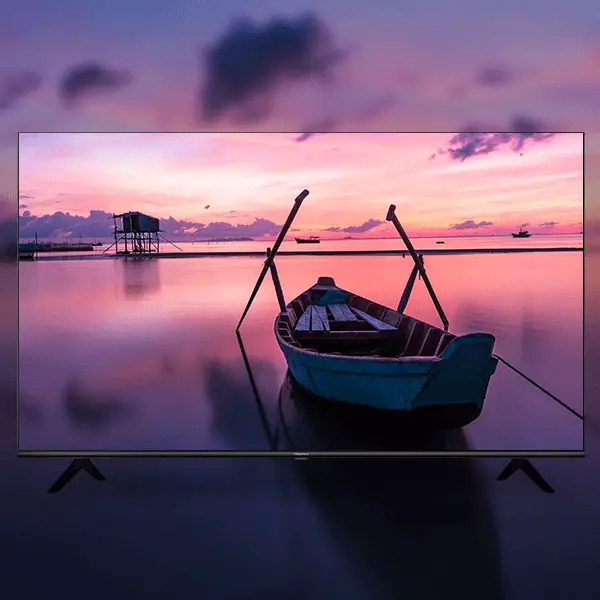
Keep in mind that the 50″, and probably 70″ sizes use VA panels instead and although we cannot confirm this by ourselves they ought to have better contrast due to this fact.
Viewing angles
The A6H we have here for testing is using an IPS-type of panel, as we already mentioned, and this usually means good things when it comes to its viewing angles especially in comparison to TVs that come with VA panels. The A6H is not featuring any wide viewing angle technology that could potentially improve even further its performance but for an LCD TV, it is very good. Not OLED good but no LCD TV can do that good even with some added layer that is used to improve this.
From what we saw the A6H retained respectable image quality up to about 40 degrees of angle which can be considered very good making this model ideal for family rooms where many people will be watching from different angles. Anything more than that and the overall quality starts to degrade a lot. But to be honest anything more than that will make viewing rather difficult to begin with so this shouldn’t be a problem at all.
As we mentioned above the 50″ and 70″ sizes use VA panels and while these certainly would offer better contrast, in terms of viewing angles they should perform worse. Keep this in mind if you are considering one the these sizes and you want it for family use but to be honest since we don’t have these sizes for testing we cannot be sure how they really behave.
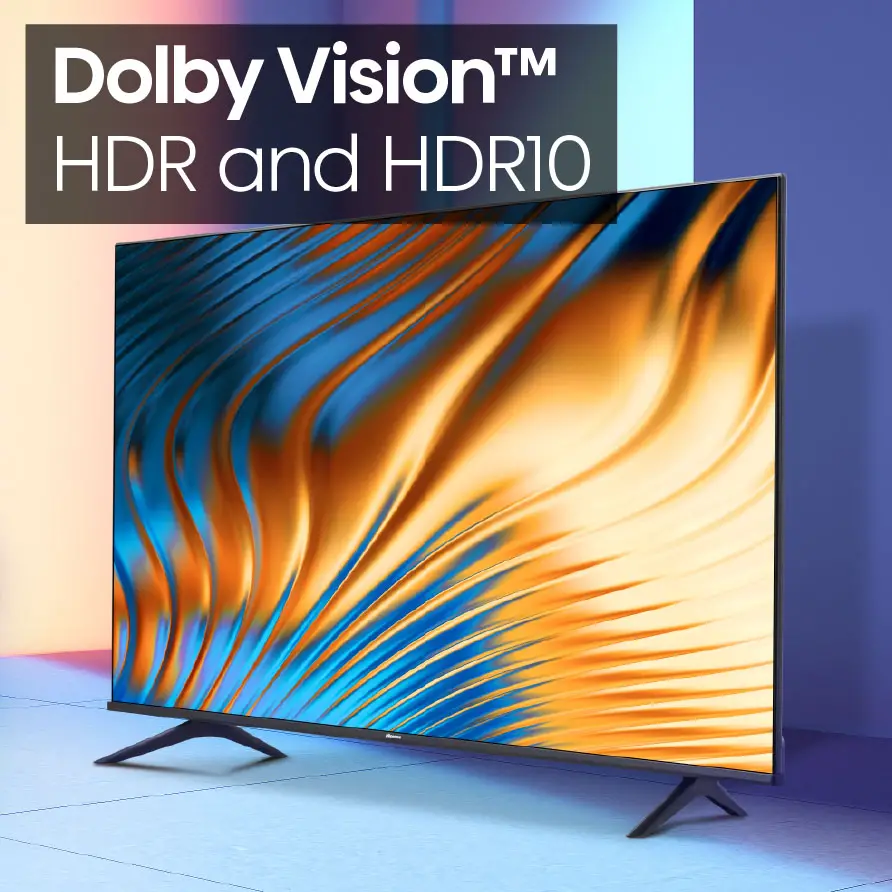
HDR support
With the current HDR war you really have to choose which camp you want to follow as not many brands support all available ones. It’s either Samsung’s HDR10+ or Dolby Vision that Sony and LG support which is really a shame as we don’t get the chance to choose all of them at any time.
The A6H seems to have added HDR10+ support something that was missing in the A6G which came only with the basic HDR10 along with Dolby Vision.
Although the TV in general cannot do much with HDR content, having all available HDR protocols in such a low cost TV really shows that Hisense is again on top of their game and the big three should take note. All TVs should support all three standards and the A6H is a prime example that you don’t need a premium release to have them.
Color coverage
Next we will be looking at the colors performance and its interesting to see how the A6H can do in this field. The unit is missing the Quantum Dot technology that we find in the ULEDs above this one and instead is using what Hisense calls Precision Color technology.
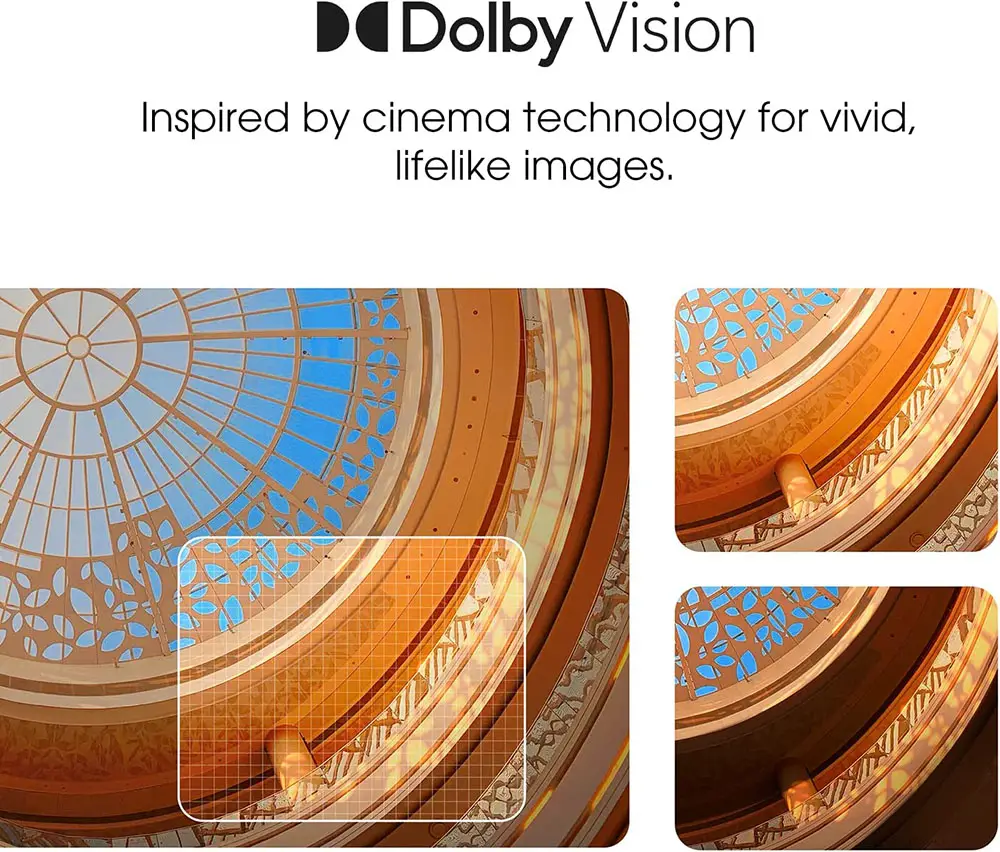
According to our measurements the A6H covers about 79% of the DCI-P3 color space which is good for its price. On the wider REC.2020 color space we got 57% coverage which may seem average but if you consider the price you pay then you shouldn’t really ask for more.
Overall the A6H behaved similar here to the A6G. We got slightly better numbers but the difference is so small that is within the margin of error. So we cannot say that this year’s model has really improved on its color output.
In terms of color gradients the A6H seems to perform slightly worse than last year. While the A6G did great here, the A6H showcased some visible banding especially with some darker greens. Unfortunately the TV is missing a smooth gradation feature that could potentially help here.
Motion performance
The A6H comes with a 60Hz panel which certainly has a negative effect on the TV’s motion performance. The difference we find in the 2022 model is that while the A6G was stripped of all motion features including Black Frame Insertion (BFI) the A6H does seem to have some limited motion interpolation capabilities.
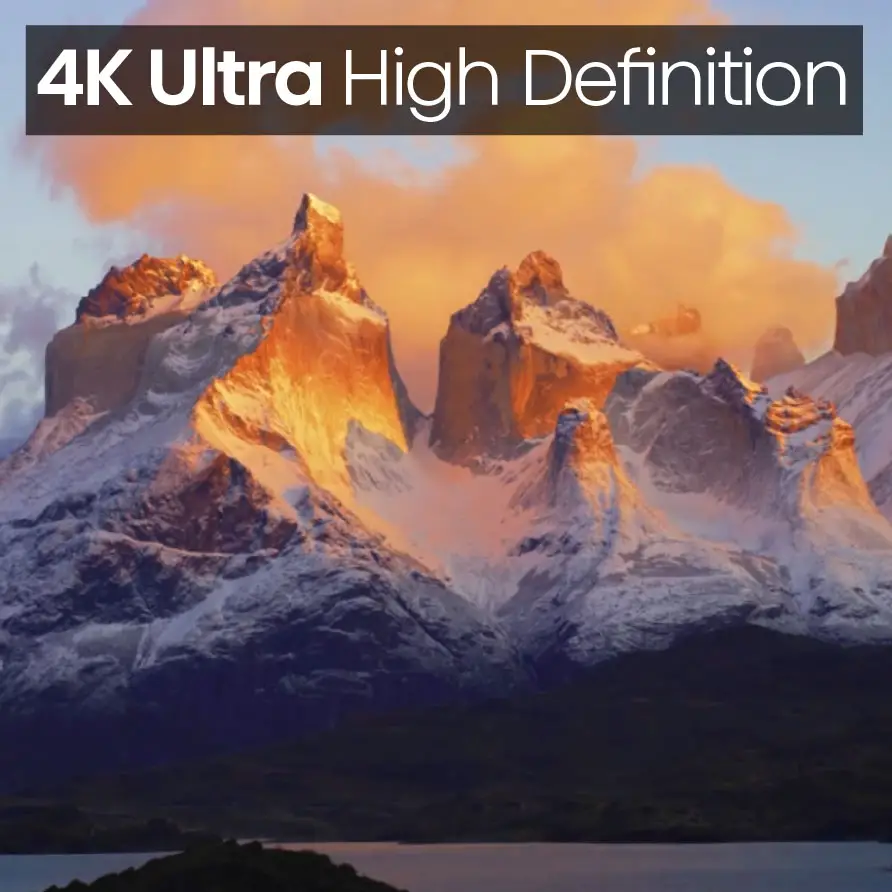
Overall motion on the A6H was ok but we did notice some image duplication probably due to the slow dimming frequency of its backlight. Also while its motion interpolation can help in certain scenes, due to its low capabilities, when there are fast action scenes a lot of artifacts make their appearance.
Another addition we get this year is the inclusion of VRR which was missing completely from the 2021 model. Only HDMI Forum VRR is natively supported so don’t expect any FreeSync or G-Sync goodness. But at least this is better than nothing.
Input lag
Judging from last year’s input lag performance we are expecting good numbers here. And this turned out to be true as a 9.6ms input lag average was measured in both 1080p and 4K resolutions which is excellent for even the most hardcore gamers and actually it is even better than what we saw in the A6G. With such a low input lag gaming can really be a pleasure but in order to get such a low value you have to keep in mind that you need to use the available Game mode.
One thing that we noticed is that while the A6G had respectable input lag even outside Game mode this was not the case with the A6H. The input lag we measured in this case was about double that of the A6G to 112.3ms.

We cannot be sure why this was the case but we took multiple measurements and all of them gave us the same numbers. As a result the A6H is good for gaming only with the Game mode engaged.
The TV may not not have any HDMI 2.1 ports but at least it supports Auto Low Latency Mode (ALLM) that can be used with any devices that support that like the PS5 and Xbox consoles and can greatly benefit users. Unfortunately, as with most Hisense releases, there is no HGiG mode available.
Before moving on we connected our PS5 to the A6H and played a bit of Call of Duty Vanguard. With Game mode enabled we had a really awesome gaming experience. No delays or response times resulted in blazing fast rendering of all our commands on screen. The A6H may be missing some gaming features like 4K@120Hz but for such a low cost unit it had a very solid and respectable performance here.
Image quality impressions
If you expect to find any improvements on the A6H over its predecessor you will disappointed. To be honest it seems that while Hisense has improved a few areas, some others got worse.
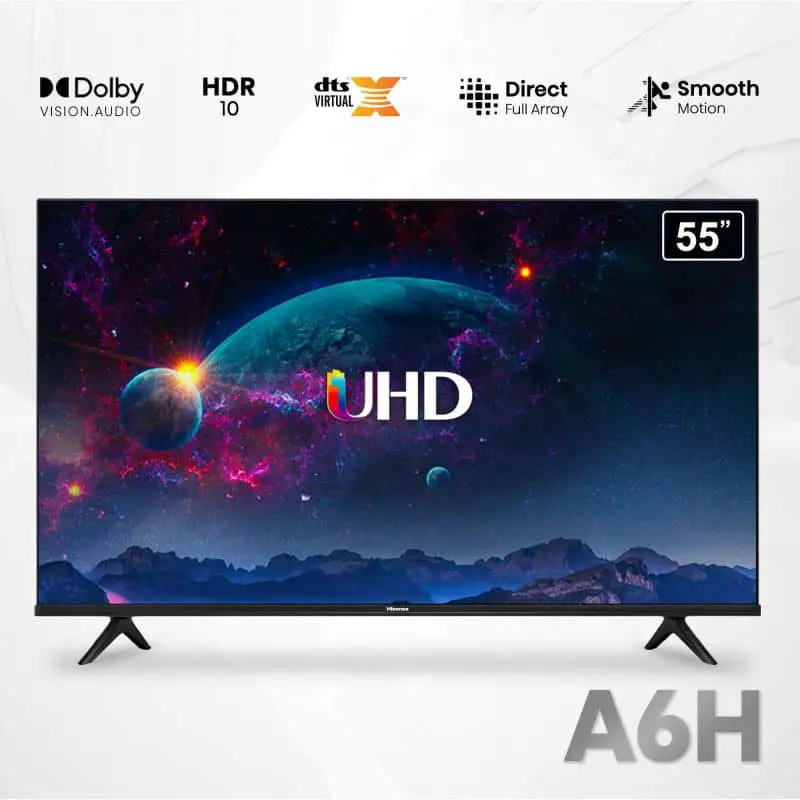
On one hand we got motion interpolation, HDR10+ and VRR support this year but on the other hand the luminance curve got worse, there was visible banding in certain colors and input lag almost doubled outside of Game mode.
In all other areas including 4K upscaling, color coverage, brightness, viewing angles, motion performance and contrast we got more or less similar numbers indicating how close the two releases are in terms of picture quality.
Audio Quality
Next in line is sound and the A6H features a pretty standard 2.0 channels audio system with a total of 16 watts of power (2 x 8 watts) which is actually a downgrade from the 2 x 10 watts of the A6G. Does this make a big difference? Not really and in real world content you will be hard to notice this.
As usual this type of system is more than adequate for casual viewing but if you plan on using the TV for movies then we would strongly suggest you to get at least a soundbar if not a full surround system.
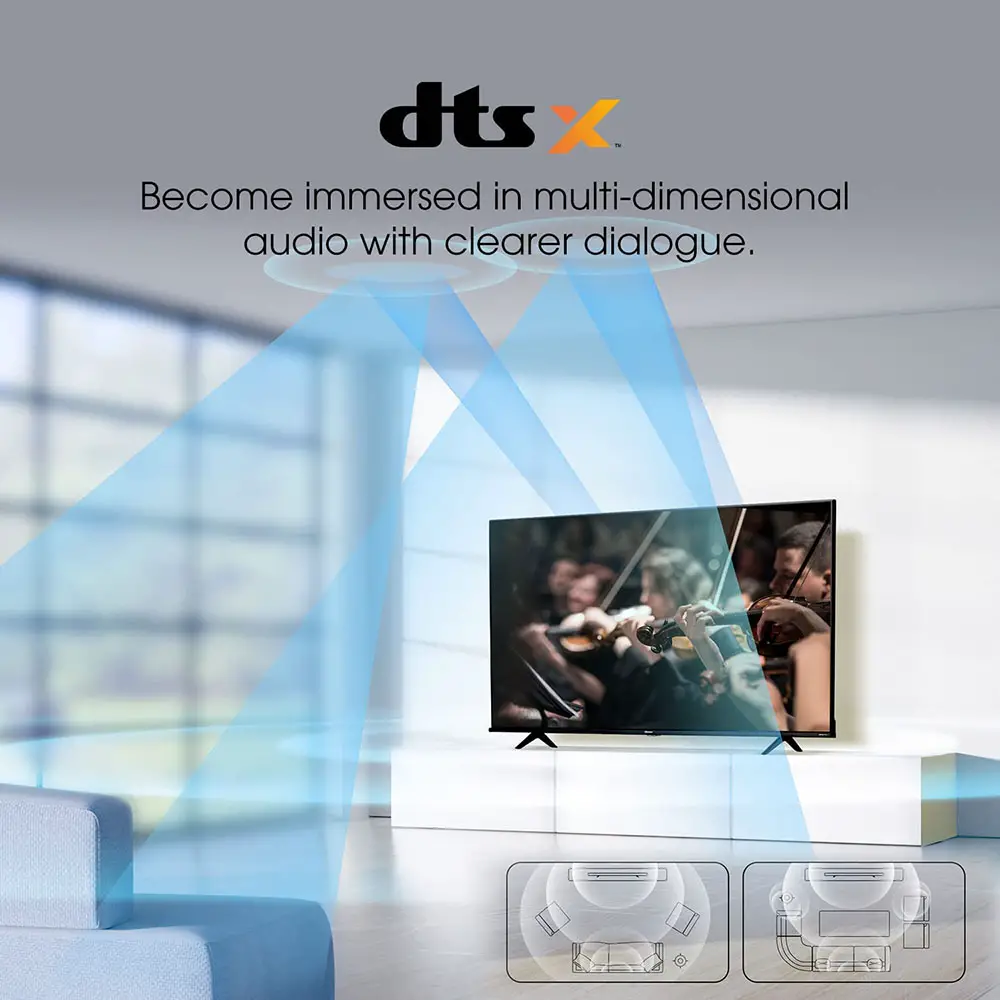
There are a few sound modes available to choose from but with so limited capabilities these wont do much to improve things altogether. The A6H doesn’t have Dolby Atmos support and instead we get DTS Virtual:X which is responsible for creating a more immersive surround output from its limited hardware.
We tried various types of content here and as we said above, for casual use the built-in system is just fine. Dialogue was distinct enough but while the TV could get loud a lot of compression would become noticeable in higher volume levels.
With Bluetooth streaming the TV grands you the ability to stream audio to some audio device like a soundbar or even headphones if these are capable of such a connection. Also you can pass audio through the available eARC port which is actually an upgrade over the A6G’s ARC.
Closing we will more or less repeat what we said in our A6G review. The hardware is very limited to offer anything more than the basics and although DTS Virtual:X is a welcome addition do not expect any miracles out of it. The TV is simply not capable for much more.
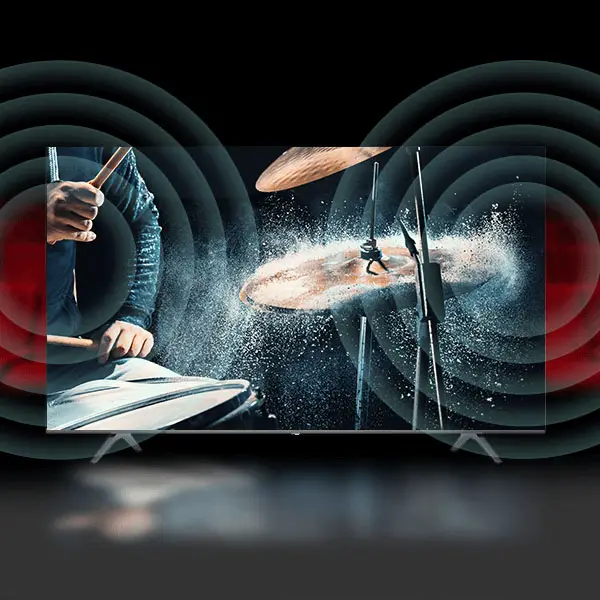
Ports and Connectivity
The A6H comes with two groups of ports, one looking sideways and one looking backwards. As we mentioned in the beginning of our review Hisense tends to use different port layouts, even for the same model, for different sizes and various markets so we cannot guarantee what we see in our TV will be exactly the same in yours.
In the side looking group we get 3 HDMI ports, 2 USB-A ports, the antenna/cable connector, a digital audio output and a RJ-45 Ethernet port. On the other group looking backwards we get a headphones jack, a composite video input and analogue stereo audio left/right inputs.
The TV does not feature any HDMI 2.1 ports as for that you will have to go for some higher tier model. The ones we have here are all HDMI 2.0 meaning they can handle a maximum of 4K@60Hz. And anyway the panel could not sustain 120Hz so there was no point to have HDMI 2.1 in the first place.
At least there is eARC in HDMI port (HDMI 1) which is an improvement over the older ARC. With it you can pass-through not only Dolby Digital and DTS signals to an outside audio device but also Dolby Atmos and DTS:X. Keep in mind that Hisense is one of the few brands that still supports DTS in their TVs.
Also the USB ports are the older 2.0 and although these shouldn’t have a problem with most files we would like to see at least one USB 3.0 available. But we cannot complain considering how lost cost this model is. Lastly the A6H, just like its predecessor, seems to be one of the few TVs that still has analog ports. So it can be very handy if you still have older equipment to connect.
As for the TV’s wireless capabilities we get built-in WiFi (802.11ac) along with the Bluetooth although it is not mentioned anywhere which version the TV uses, which is very typical of Hisense.
The TV comes with plenty of connectivity options and although it is missing HDMI 2.1 these wouldn’t matter in such a low performing unit. The A6H seems very flexible here.
OS, Apps and Features
Unlike Sony, Hisense decided to keep the Android TV OS in their TVs last year, but it seems that for 2022 they finally decided to change and as a result the A6H seems to be one of the first releases to be using the new Google TV 11.0 as most of Sony’s 2022 releases still use last year’s Google TV 10.0.
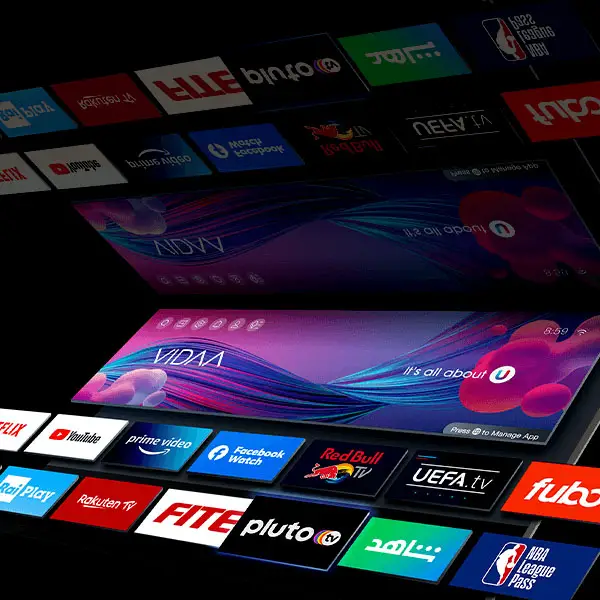
Now, we need to do special mention on the OS because Hisense is one of the few companies that use different OS for the same model in different regions. As a result the US version of the A6H comes with Google TV while some European markets among others use the VIDAA U5 OS. We cannot be sure about all markets so please check yours to be sure what you are getting.
Now many of you may be puzzled what the difference between Android TV and Google TV is. Well, it’s not so much difficult to understand what has changed really. Google TV is still Android TV but with an extra layer on top of it. Think of it like it is in Android smartphones. Most manufacturers that use Android in their releases they use on top of that their own layer that gives this extra something to their UI that make them unique both in appearance and functionality.
The same is with Google TV. You still basically use Android TV but there is the extra Google TV layer on top in order to make the UI feel different both in looks and functionality. The new Google TV 11.0 doesn’t seem to be vastly different from the Google TV 10.0 we have experienced in many 2022 Sony TVs. There are some refinements here and there and some minor additions but overall this is basically the same OS from before.
Google TV seems to have been designed around recommendations, either it be movies, TV shows or applications and this seems to be the main focus of the latest OS in general. During setup the wizard asks you of what specific streaming services you use in order to customize the Home screen recommendations.
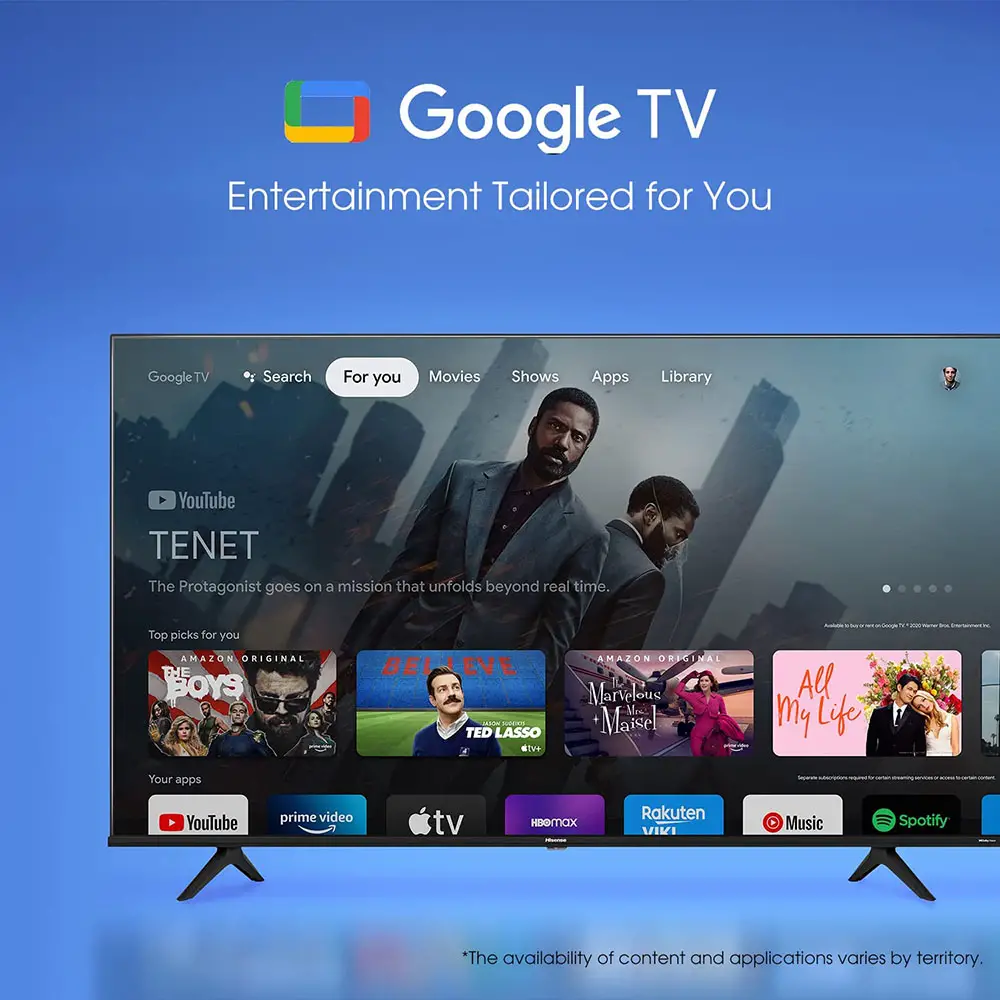
Google TV, in our opinion, is far better than any version of Android TV that came before. Surely, it needs a bit of getting used to but after a while it’s easy to navigate around its menus and multiple settings. And with the A6H everything was smooth enough and all apps would open relatively fast.
If there is one thing that Android has in abundance that is definitely the huge support from developers. Through the included Google Play you can find literally thousands of apps that you can download and use except from the pre-installed ones. There is so much content available that you will definitely find the ones you are looking for and the list goes on and on.
Some of the most prominent names are all accounted for including Disney+, HBO NOW, Hulu, Prime Video, SHOWTIME, Pandora, Sling TV and YouTube. As always some of them are region dependent so make sure the ones you are interested in are working in your area.
Chromecast is also available and it gives you the ability to stream content from other Chromecast enabled devices like mobile phones and tablets directly to the TV. Voice control is also present as you can use the remote’s built-in microphone to give commands to Google Assistant. Unfortunately no Amazon Alexa built-in but with the A6H having Google TV this was to be expected.

We have seen the same thing in many other TVs that were using Android TV or Google TV so probably this has to do with the fact that it’s using Google’s Android system and thus having Alexa built-in was not possible. With voice control you can issue various commands to the TV but functionality extends far beyond that as you can control any smart devices you have in your house also.
There is also a built-in media player available that you can use to playback various video and audio content from any external storage connected to the USB ports. The list of files and codecs supported is rather extensive and in fact we can say that the A6H has wider support than some 2021 Hisense models. Also audio support has been improved as now except from MP3 files it can also playback AAC, WAV and FLAC.
From various files we tested we can affirm that the built-in media player is an improvement over last year’s offerings. Obviously some very demanding files or some strange codec combinations still refused to play but overall it performed really good. Some years ago we wouldn’t even think to use the built-in media players in these TVs but things have dramatically changed the last couple of years.
The Hisense A6H is a bit improved in this area. It is not drastically different from before but the new Google TV 11.0 feels better and smoother, some minor additions are always welcome and the improved media player can surely be handy. So expect to get everything the 2021 models had and then some.

Final Thoughts
When we are reviewing low cost TVs a lot of people ask us why do we score them so high compared to other reviewers. We do this because most reviewers don’t take into account the price and score entirely based on their performance which is not all that fair to be honest. The Hisense A6H comes with an astonishing price of $319 for the 55″ which in fact is around $70 cheaper than the A6G’s price tag last year.
For a cheaper price you get practically the same image performance and some slight additions and improvements like Google TV 11.0, VRR, HDR10+, motion interpolation and a better media player. So what this TV offers in combination to its lower cost certainly ups its value considerably. The A6H remains a low performing TV, no question about it, but if you are very tight on budget then we cannot recommend any other TV on this price with so many features as this one.
On its downsides its brightness performance surely leaves a lot to be desired. Contrast was less than stellar with blacks appearing greyish most of the times while colors were a bit flat and uninspiring. Audio output was good for casual use but nothing more and there are no HDMI 2.1 ports so you cannot use it for high frame rate gaming.
The Hisense A6H feels like a refined A6G and there are more similarities between the two than differences. But its overall value is greater as the combination of lower cost and further additions to its features makes it an unbeatable choice in this price range. For $319 (for the 55″) you will most certainly not find another TV that has the same features as the A6H. Thus it deserves our highest recommendation in its category.
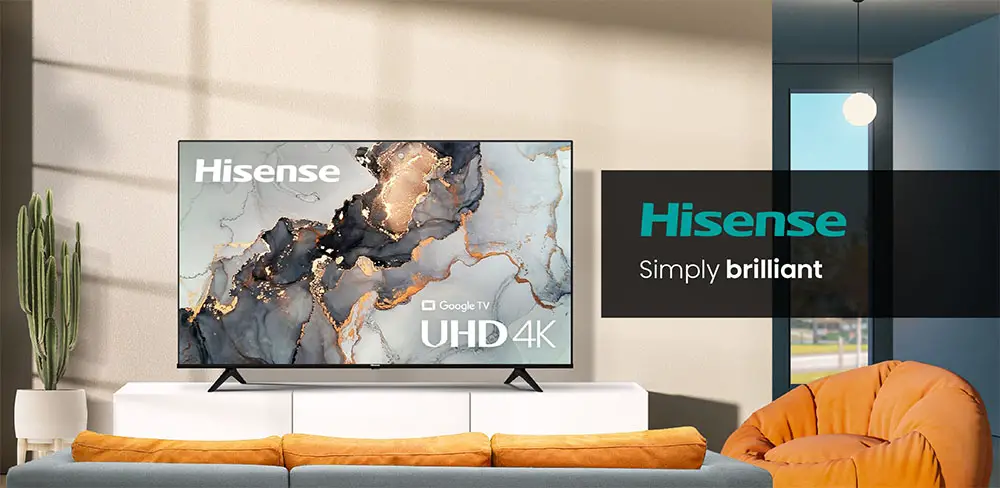
For more reviews you can check our dedicated 4K LED LCD TV reviews list or even look at our Product Reviews Table where you can find the brand and specific product you are looking for.
Cheapest Places to Buy :
*We are a reader-supported website. When you buy through links on our site, we may earn a small affiliate commission at no extra cost to you. Home Media Entertainment does not accept money for reviews.*
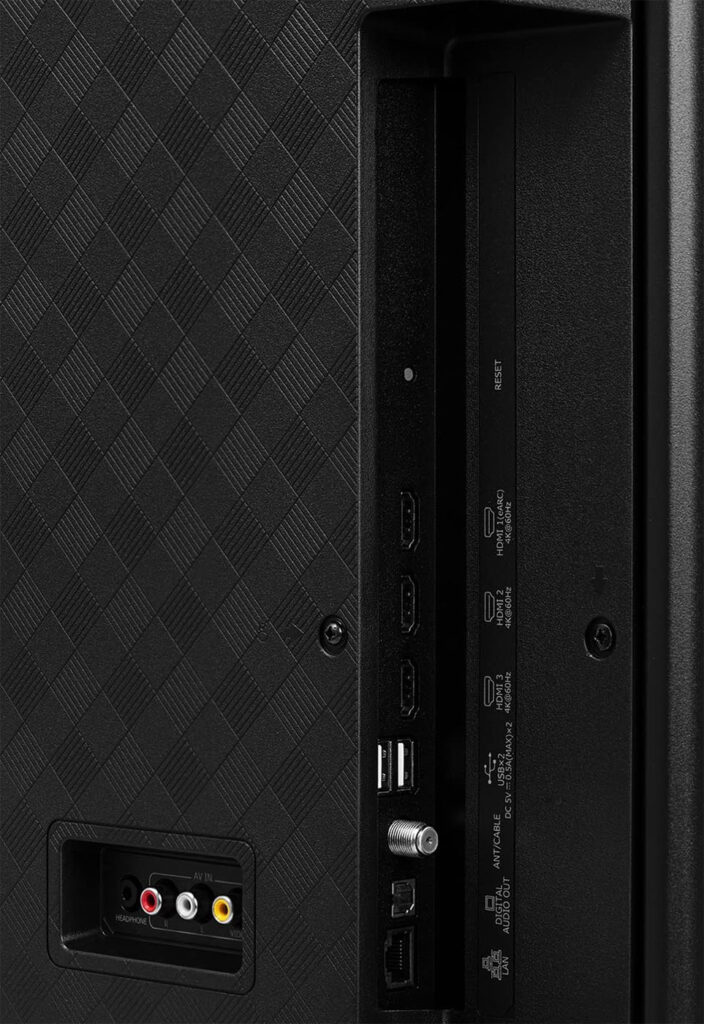
Hi Stratos,
I have been eyeing Hisense for some time now and especially I was looking at some of the lower budget models and I am astonished what they offer for their price. They surely price them far more aggressive than the big three but I guess this was to be expected. I was thinking to go for the A6G for my bedroom but now that I see the lower price of the A6H it got me thinking. What do you think about it?
Hello Rohit. Definitely go for the A6H. Although I don’t know what prices you can find these two but the A6H is comparable to the A6G and has a couple of extras that the 2021 model is missing. If I were you I would choose the A6H definitely.
I had a Hisense in the past and although I was a bit skeptical for their quality at first I never had a problem for the time I used it. Now I am looking at one of their better releases but I thought to take a look at your review of the A6H. It’s a bit on the cheap category for me as I am looking for some better performance but anyway great review as always from your website.
Hey Dale. We will be reviewing some of the higher tier models from Hisense soon so keep coming back and you will find some of them soon enough.
SO basically its like 6,2-6,6% in real review, its just very budget model for everyday watching, if you want anything better its A7H not this actually^^
Hello Kruger. I don’t agree with this “real review” comment. What does real review means? By what standards. For us with the price of the A6H it deserves an 8.8 score. It all depends on the price. And not everyone has the same standards. Maybe for you is a very budget model but for other will suffice. Never judge a product only by your standards but looking at the market as a whole.
Hi there. How does the A6H compare to the SAMSUNG 65 INCH AU7000?
Hello Zameer. Unfortunately we hadn’t tested the AU7000, only the AU8000. So I cannot tell you if they compare or not.
Wonderful detailed review on Hisense TV. I am interested to know whether can it be used as frame or art slide show?
Thanks in advance
Hello there. I am not sure I understand your question. You mean if the TV can display art and images like Samsung’s ambient mode?